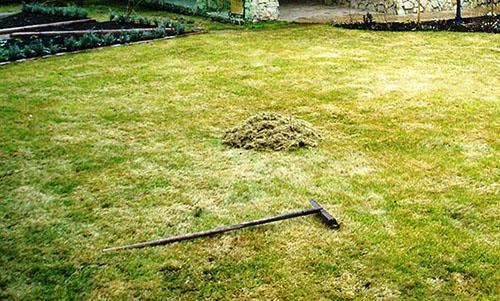When should you fertilize your lawn after winter?
If one or more varieties of perennial lawn grass were used for landscaping the land plot of the local area, then when should the lawn be fertilized after winter?

It is difficult to find a habitable land plot where not enough attention has been paid to the improvement of the adjacent territory. By planting lawn grass, you can create an excellent natural backdrop, thereby providing soil coverage in half or most of the garden plot.
Benefits of Perennial Lawn Grasses
Plants for the lawn can be either one or perennial. Perennial herb varieties have several characteristics:
- have increased indicators of frost resistance;
- in winter, such crops are characterized by complete death of the ground part of the plant;
- with the beginning of the spring season, the plant shoots grow back from the preserved root.
Such lawns sprout, gradually filling the soil. Perennial varieties of lawns provide dense landscaping and give abundant flowering in the future. The main condition for the perfect appearance of the lawn, uniform coverage and color saturation is the correct measures for the care of the vegetation cover, including planned feeding procedures. Special attention should be paid to the issue of landscaping with the arrival of heat and melting of snow, when it is necessary to fertilize the lawn after winter in order to restore it.
Features of care in the spring
Absolutely all plants need regular feeding. Such recharge is especially relevant in the spring, as the growing season begins. Recommendations for feeding the lawn state that the procedure must be carried out three times, but it should be noted that the first fertilization is carried out after the snow melts. Such a fertilization technique is based on the absorption of all useful elements by moist soil.
The effectiveness of feeding depends on the following factors:
- fertilizing exclusively in wet soil;
- correspondence of the type of feeding to the planted plants;
- fertilizers applied in the spring are mostly characterized by an increased nitrogen content;
- rationing of consumed dressings varies within the limits of 30 - 50 g / m2;
- the best period for feeding is the moment before the young growth begins.
Dry fertilization techniques
Having correctly planned the time, choosing the type of fertilizer suitable for the planted grasses, you can begin activities to recharge the soil and planted crops.
There are several ways to apply fertilizer to wet soil:
- Manual spreading of dry fertilizers over an area with an unripe lawn. This method is rather ineffective due to the excessive labor intensity and the possibility of uneven distribution of nutrients over the earth's surface.
- Spread fertilizer using a mechanical garden spreader. This method will not only shorten the duration of the work carried out, but also save the consumption of the applied top dressing.
Associated procedures for the restoration of a perennial lawn
Top dressing of the lawn in the spring is far from a one-step procedure, based solely on spreading dry nutrients.
To help the perennial lawn recover and ensure its most attractive appearance, such works should be implemented in stages as:
- After applying top dressing to the soil, a pause of 1.5 - 2 weeks should be maintained. During this period, no action should be taken towards the development and improvement of this site.
- After the allotted time, as the top layer of the lawn area dries out, carefully remove all found plant residues.
- It is necessary to get rid of the crust formed during the winter by carrying out work on verticulation, when the plant felt from the surface of the earth is lifted by the implementation of vertical movements.
In parallel with scarification, scarification is encouraged, which implies a kind of scraping off unnecessary elements at the site of grass germination. In the absence of an opportunity to feed the lawn immediately after the snow melts, it is possible to correct this by introducing additional food after scarification.
The need for mandatory aeration of the site
Top dressing will not give positive results if actions have not been taken to aerate the site. Considering the fact that during the winter the soil becomes denser, harder, accumulates carbon dioxide in quantities that are detrimental to lawn plants. The flow of air to the roots of plants can not only be hampered, but blocked. To avoid oxygen starvation of the roots, aeration work should be carried out in any available way.
The most common ones are:
- using special gardening equipment, which allows you to change the nozzles and parameters of the depth of soil puncture;
- manually, using a conventional garden fork.
Such manipulations will provide not only the flow of oxygen into the soil, but also contribute to the accelerated oxidation of the applied fertilizers.
In the second half of April, care should be taken to carry out measures aimed at controlling weeds. The most effective is the method of applying herbicides, removing weeds even at the stage of formation.